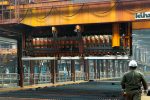(Corrects advisory that $2-5 bln is estimated cost to retrofit technology to Australia's six existing alumina refineries, not cost per refinery, in paragraph 10. No change to story text.)
MELBOURNE, June 17 (Reuters) – Alcoa Corp detailed plans on Thursday for a "step change" in alumina production that would allow it to cut 70% of emissions from the carbon intensive process by tapping renewable energy.
Among Australia's emissions intensive exports, alumina and aluminium would be the most at risk from carbon border tariffs that the European Union is set to announce in July, says think tank the Australia Institute.
"It's going to take to around 2030 or so before you get the technology ready to roll out…lots of planning will be needed to make this come together," company official Ray Chatfield told a conference in the city of Perth.
The Australian government has issued grants to help decarbonise the alumina refining process by which aluminium is made and which contributes about 24% of the country's direct manufacturing emissions, or more than 14 million tonnes of carbon dioxide in 2019, government agency data show.
But Australia could leverage its abundant renewable power, providing a strategic advantage for building out more green alumina production, Chatfield, Alcoa's global technical manager for refining energy, said.
The process would replace the natural gas used to generate high-pressure steam with compressors that would capture waste vapour to generate heat. Such compressors would be powered by renewable energy supplied from a power grid.
The process would also cut water use by about 25 gigalitres per year, he said.
About 1,200 MW of new renewable power is required to fully implement the mechanical vapour recompression (MVR) process at Australia’s six alumina refineries, three run by Alcoa, two by Rio Tinto and one by South32, Chatfield said.
Last month, Alcoa received a government grant to test the technology at scale at its Wagerup refinery in Western Australia by the end of 2023.
But adapting Australia's existing refineries for the new process would call for significant investment of $2 billion to $5 billion, and the technology needs to be proved before it can be adopted, Chatfield added.
This week, Rio Tinto said it would look to cut carbon from the calcination process, which contributes a further 24% of process emissions, by replacing natural gas with hydrogen. The remaining 6% of emissions comes from power imports. (Reporting by Melanie Burton; Editing by Clarence Fernandez)



 Follow us on Twitter
Follow us on Twitter Become our facebook fan
Become our facebook fan










Comments are closed.